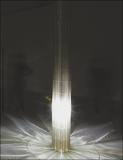| dc.contributor.author | Inamura, Chikara | |
| dc.contributor.author | Stern, Michael | |
| dc.date.accessioned | 2020-05-15T14:06:31Z | |
| dc.date.available | 2020-05-15T14:06:31Z | |
| dc.date.issued | 2018-12 | |
| dc.identifier.issn | 2329-7670 | |
| dc.identifier.issn | 2329-7662 | |
| dc.identifier.uri | https://hdl.handle.net/1721.1/125261 | |
| dc.description.abstract | Advancements in manufacturing during the Industrial Revolution enabled the widespread use of glass in buildings and household objects. Nonetheless, processes for the fabrication of complex geometry and custom objects with glass remain elusive. We present G3DP2 - a second iteration of the novel additive manufacturing (AM) technology for transparent glass products developed by The Mediated Matter Group at MIT. One of the oldest production materials, glass involves complex material chemistry and requires extreme working temperatures underlying the persistent challenges associated with its design and production. AM with molten glass presents a potential path toward production of highly complex geometry and custom-designed objects while retaining the optical transparency and chemical stability available through traditional manufacturing processes. G3DP2 is a new AM platform for molten glass that combines digitally integrated three-zone thermal control system with four-axis motion control system, introducing industrial-scale production capabilities with enhanced production rate and reliability while ensuring product accuracy and repeatability, all previously unattainable for glass. A series of material characterizations were conducted to evaluate the mechanical properties of the 3D-printed glass products produced by G3DP2. A set of 3-m-tall glass columns was designed, engineered, and digitally fabricated for Milan Design Week 2017, highlighting the geometric complexity, accuracy, strength, and transparency of 3D-printed glass at an architectural scale for the first time and a critical step in utilizing the true structural capacity of the material. Together, the installation and the G3DP2 platform serve as a foundation for future work and suggest exciting possibilities associated with the digital fabrication of glass as well as potential applications in product and architectural design. Keywords: 3D printing, additive manufacturing, glass, glass structures, printed glass, transparent | en_US |
| dc.language.iso | en | |
| dc.publisher | Mary Ann Liebert Inc | en_US |
| dc.relation.isversionof | http://dx.doi.org/10.1089/3DP.2018.0157 | en_US |
| dc.rights | Article is made available in accordance with the publisher's policy and may be subject to US copyright law. Please refer to the publisher's site for terms of use. | en_US |
| dc.source | Mary Ann Liebert | en_US |
| dc.title | Additive Manufacturing of Transparent Glass Structures | en_US |
| dc.type | Article | en_US |
| dc.identifier.citation | Inamura, Chikara, et al. “Additive Manufacturing of Transparent Glass Structures.” 3D Printing and Additive Manufacturing 5, 4 (December 2018): 269–83. © 2018 Mary Ann Liebert, Inc. | en_US |
| dc.contributor.department | Massachusetts Institute of Technology. Media Laboratory | en_US |
| dc.relation.journal | 3D Printing and Additive Manufacturing | en_US |
| dc.eprint.version | Final published version | en_US |
| dc.type.uri | http://purl.org/eprint/type/JournalArticle | en_US |
| eprint.status | http://purl.org/eprint/status/PeerReviewed | en_US |
| dc.date.updated | 2019-07-23T15:30:59Z | |
| dspace.date.submission | 2019-07-23T15:31:01Z | |
| mit.journal.volume | 5 | en_US |
| mit.journal.issue | 4 | en_US |
| mit.metadata.status | Complete | |
